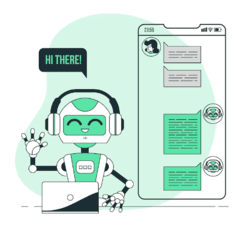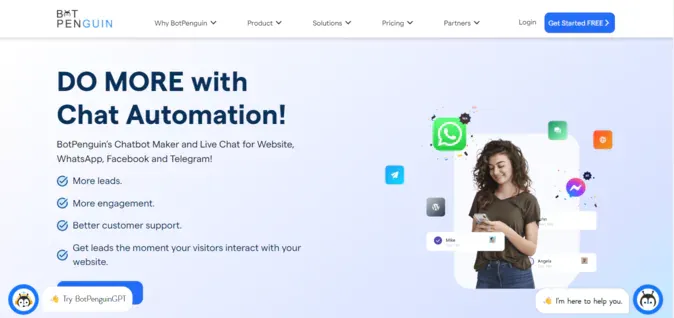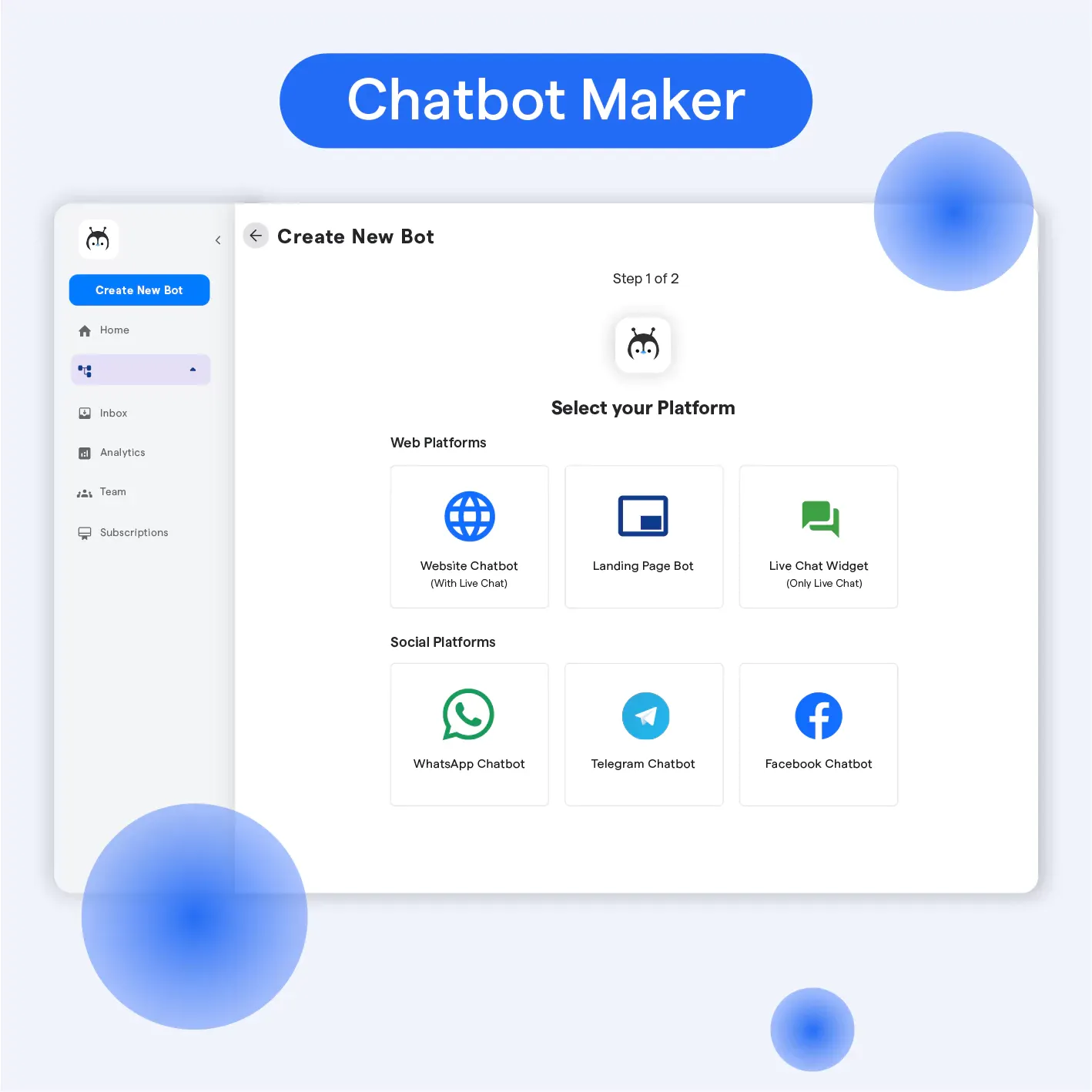What is a Chatbot Maker?

A chatbot creator is an application or platform that enables users to develop, design, and implement chatbots for different functions like customer assistance, sales, or information gathering. These tools frequently provide pre-built templates, natural language understanding features, and user-friendly interfaces, allowing users to build chatbots without the need for programming expertise.
Why Use a Chatbot Maker?
Enhancing Customer Experience
Chatbots can provide instant support to customers, answering their queries and guiding them through processes in real-time. By using a chatbot maker, businesses can create customized chatbots that cater to their specific audience, ensuring a personalized and efficient customer experience.
Automating Repetitive Tasks
Chatbot makers can help businesses automate repetitive tasks, such as answering frequently asked questions or guiding users through standard processes. This frees up valuable time for employees to focus on more complex tasks and allows for more efficient use of resources.
Reducing Operational Costs
By automating tasks and providing instant support, chatbots can help businesses reduce their operational costs, particularly in customer service departments. Using a chatbot maker to create and deploy these chatbots can be a cost-effective way to improve efficiency and reduce overheads.
Increasing Sales and Conversions
Chatbots can guide potential customers through the buying process, answering questions, and providing product recommendations. By using a chatbot maker, businesses can create targeted chatbots that help increase sales and conversions.
How to Choose the Right Chatbot Maker?
Step 1
Assessing your Business Needs
Before selecting a Chatbot maker, it's essential to assess your business needs and goals. Consider the purpose of your chatbot, the platforms you want to integrate with, and the level of customization required. This will help you narrow down your options and choose a chatbot maker that aligns with your objectives.
Step 2
Comparing Features and Pricing
Different chatbot makers offer varying features and pricing models. Compare the available options, taking into account the features they provide, such as natural language processing, analytics, and integration capabilities. Also, consider the pricing model and whether it suits your budget and long-term plans.
Step 3
Evaluating User Interface and Ease of Use
Choose a chatbot maker with an intuitive user interface and a gentle learning curve. This will ensure that you can create, customize, and deploy your chatbots with ease, even if you have no prior experience in chatbot development.
Top Chatbot Creation Platforms
1. BotPenguin

BotPenguin offers an AI-driven chatbot builder platform, enabling businesses to develop custom chatbots for websites, social media, and messaging applications. With its intuitive interface and comprehensive features, BotPenguin is a favored choice for companies seeking to boost customer support and engagement.
2. Botpress
Botpress is an open-source platform for chatbot development, supplying developers with the necessary tools to create, deploy, and manage chatbots across various platforms. Its modular architecture allows developers to effortlessly build powerful chatbots.
3. Tars
Tars provides a chatbot builder platform for businesses to develop conversational chatbots for websites and messaging apps. Featuring a drag-and-drop interface, Tars simplifies chatbot design and construction without requiring coding expertise.
4. Tidio
Tidio is a chatbot builder platform tailored for small businesses to enhance customer support and sales. With its user-friendly interface and robust features, Tidio allows businesses to craft chatbots capable of addressing customer inquiries, capturing leads, and delivering personalized suggestions.
Key Features of Chatbot Makers
Natural Language Processing (NLP)
NLP is an essential feature of chatbot makers, enabling chatbots to understand and interpret human language. This technology allows chatbots to process user inputs, identify intents, and generate appropriate responses, resulting in more natural and engaging conversations.
Integration with Messaging Platforms
Chatbot makers often provide seamless integration with popular messaging platforms like Facebook Messenger, WhatsApp, and Slack. This feature allows businesses to deploy their chatbots across multiple channels, reaching a wider audience and providing a consistent user experience.
Customization and Branding
Chatbot makers typically offer customization options that enable businesses to design chatbots that align with their brand identity. Users can customize the chatbot's appearance, language, and conversation flow to create a unique and personalized experience for their customers.
Analytics and Reporting
Analytics and reporting features in chatbot makers help businesses track the performance of their chatbots, gain insights into user behavior, and identify areas for improvement. These features often include data on user engagement, response times, and conversation metrics.
How to Create a Chatbot Using a Chatbot Maker?
Step 1
Defining your Chatbot's Purpose
Before you start building a chatbot, it's crucial to define its purpose and objectives. Consider the goals you want your chatbot to achieve, such as improving customer support, increasing sales, or engaging users on social media.
Step 2
Designing the Conversation Flow
Design the conversation flow by mapping out the possible interactions between the chatbot and users. This process involves creating a series of questions, responses, and actions that guide users through the conversation and help them achieve their goals.
Step 3
Training the Chatbot
Once you've designed the conversation flow, it's time to train your chatbot using natural language processing (NLP) techniques. This step involves feeding the chatbot with sample data, such as user queries and responses, to help it learn and improve its understanding of human language.
Step 4
Testing and Deploying the Chatbot
Before deploying your chatbot, test it thoroughly to ensure it functions correctly and provides a seamless user experience. Once you're confident in your chatbot's performance, deploy it across your chosen messaging platforms and start engaging with your audience.
Tips for Optimizing your Chatbot
Continuously Monitor and Improve
Like any other technology, chatbots require continuous monitoring and improvement. Keep an eye on your chatbot's performance, identify areas where it may be struggling, and make necessary adjustments. By doing so, you'll ensure that your chatbot remains relevant, efficient, and engaging for users.
Personalize User Experiences
One size doesn't fit all when it comes to chatbot interactions. Personalizing user experiences can make your chatbot more engaging and effective. By tailoring responses and actions based on user preferences, demographics, and interaction history, you can create a more meaningful and enjoyable experience for your users.
Leverage User Feedback
User feedback is a goldmine of information for optimizing your chatbot. Encourage users to provide feedback on their experiences and use this input to refine your chatbot's performance. This will help you identify areas for improvement and ensure your chatbot is meeting your users' needs and expectations.
Keep Conversations Clear and Concise
Chatbots should be easy to interact with and understand. To achieve this, ensure that your chatbot's conversations are clear, concise, and free of jargon. By keeping things simple, you'll make it easier for users to engage with your chatbot and get the information they need quickly and efficiently.
Challenges and Limitations of Chatbot Makers
Handling Complex Queries
Chatbots can sometimes struggle with complex queries or situations that require a deeper understanding of context. To overcome this limitation, consider incorporating advanced AI and natural language processing (NLP) capabilities into your chatbot. This will enable it to better understand and respond to complex user requests.
Ensuring Data Privacy and Security
Data privacy and security are critical concerns for chatbot makers. To protect user information and comply with relevant regulations, it's essential to implement robust data privacy and security measures. This includes encrypting data, ensuring secure data storage and transmission, and regularly monitoring and updating your chatbot's security protocols.
Overcoming Language and Contextual Barriers
Language and contextual understanding can be challenging for chatbots. To overcome these barriers, consider incorporating multilingual capabilities and advanced NLP techniques into your chatbot. This will enable it to better understand user intent and respond appropriately, regardless of language or context.
Frequently Asked Questions
What are Chatbot Makers?
Chatbot Makers are platforms or tools that help you create and deploy chatbots for websites, messaging apps, or social media without requiring extensive coding knowledge.
How much do Chatbot Makers cost?
Pricing for Chatbot Makers varies, with options ranging from free plans to monthly subscriptions or pay-as-you-go models depending on features and usage.
Are Chatbot Makers suitable for non-programmers?
Yes, many Chatbot Makers offer user-friendly interfaces and templates, making it easy for non-programmers to create and customize chatbots.
Can I integrate Chatbot Makers with my existing CRM or tools?
Most Chatbot Makers support integrations with popular CRM systems and other tools, allowing seamless data sharing and improved workflow.
How long does it take to create a chatbot using a Chatbot Maker?
The time required varies, but with user-friendly Chatbot Makers, you can create a basic chatbot in just a few hours or even minutes.


